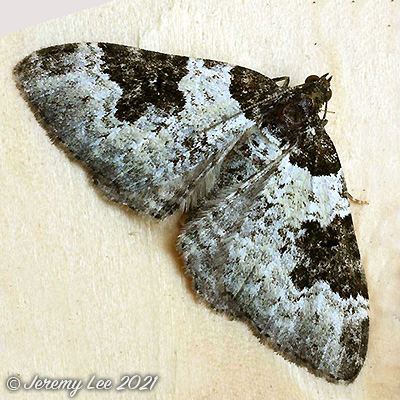
 |
|
Scientific Classifications explained » Amphibians » Ants » Aphids » Bees » Beetles » Birds » Bugs » Butterflies » Caterpillars » Damselflies » Dragonflies » Earwigs » Flies » Frog/Leafhoppers » Fungi » Galls » Grasshoppers » Harvestmen » Hoverflies » Lacewings » Ladybirds » Leaf Mines » Lichens » Mammals » Millipedes » Mosses » Moths » Sawflies » Slugs » Snails » Spiders » Trees & Shrubs » Wasps » Wild Flowers » Woodlice » Postboxes |
UK Nature > Moths > Xanthorhoe fluctuata

Scientific Name: Xanthorhoe fluctuata Common Name: Garden Carpet Xanthorhoe fluctuata, more commonly known as the Garden Carpet, has a wingspan of 18-25 mm and is a member of the Geometridae family. It is a common species throughout the British Isles, showing a preference for suburban habitats, but can be found almost anywhere. The wings are greyish-white with three irregular black blotches along the costa of the forewing, the largest in the middle. Occasionally, much darker (melanic) forms occur. The species has an exceptionally long flying season spanning two or three broods, and the adults can be seen any time from April to October. It flies throughout the night and is attracted to light - it is one of the species most likely to be seen at lighted windows. The larva is grey or green with pale, diamond-shaped markings along the back. It usually feeds on crucifers: both cultivated brassicas and wild species such as flixweed, garlic mustard, perennial wall-rocket, wallflower and wild radish. It has also been recorded feeding on nasturtium. The species overwinters as a pupa. |
|

https://www.uknature.co.uk is a website dedicated to showing the immense diversity of UK nature and wildlife. Our vast range of habitats, from lowland arable to snow covered mountains, from storm-ravaged coastlines to peaceful inland freshwater lakes and rivers, from dry, sandy heaths to deciduous and coniferous forests, all these habitats contribute to the abundance of UK nature. We have wild birds in huge numbers either residing or visiting our shores (597 recorded species as at July 2013) and we must also not forget the humble back garden with its grass lawns, flower beds filled with nectar rich flowers, shrubs and trees, all designed to attract huge numbers of insects such as bees, moths, butterflies and hoverflies; and finally the small ponds which provide safe havens for frogs, toads, newts and even slow worms and grass snakes. www.uknature.co.uk is the showcase for my personal passion, photographing uknature in all its glory. I sincerely hope you all enjoy the fruits of my labours. This site and all images contained therein is © Jeremy Lee 2004 - 2025. All Rights Reserved. Site design by Jeremy Lee. Site development & IT Support by Stuart Lee. |